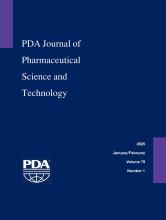Abstract
The reduction of visible particles in injectable products is an important element in the consistent delivery of high-quality parenteral products. An important part of this effort is the control of particles that may emanate from the primary packaging materials. The Parenteral Drug Association (PDA), with the support of the Pharmaceutical Manufacturers Forum (PMF) has undertaken the task of developing test methods to assess the cleanliness of primary packaging components used in the manufacture of sterile injectable products. Further work is focused on end-to-end analysis of the supply chain to identify additional points where particles may enter the finished product workflow. This includes shipment, receipt, transfer and fill and finishing operations. This information and appropriate corrective actions and control methods, coupled with appropriate patient risk-based acceptance limits, are intended to provide better and more consistent supply of injectable products that meet current compendial and Good Manufacturing (GMP) expectations. Aligning control limits between supplier and pharmaceutical manufacturers will offer further improvement. This paper describes the formation of a task force to address these needs and current progress to date.
- Received June 18, 2018.
- Accepted July 18, 2018.
- Copyright © 2018, Parenteral Drug Association
PDA members receive access to all articles published in the current year and previous volume year. Institutional subscribers received access to all content. Log in below to receive access to this article if you are either of these.
If you are neither or you are a PDA member trying to access an article outside of your membership license, then you must purchase access to this article (below). If you do not have a username or password for JPST, you will be required to create an account prior to purchasing.
Full issue PDFs are for PDA members only.
Note to pda.org users
The PDA and PDA bookstore websites (www.pda.org and www.pda.org/bookstore) are separate websites from the PDA JPST website. When you first join PDA, your initial UserID and Password are sent to HighWirePress to create your PDA JPST account. Subsequent UserrID and Password changes required at the PDA websites will not pass on to PDA JPST and vice versa. If you forget your PDA JPST UserID and/or Password, you can request help to retrieve UserID and reset Password below.






